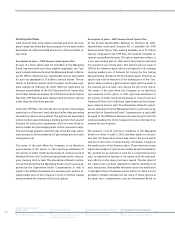Siemens 2009 Annual Report Download - page 282
Download and view the complete annual report
Please find page 282 of the 2009 Siemens annual report below. You can navigate through the pages in the report by either clicking on the pages listed below, or by using the keyword search tool below to find specific information within the annual report.
Reports Supervisory Board /
Managing Board Corporate Governance Management’s discussion and analysis Consolidated Financial Statements
Consolidated Statements of Income Consolidated Statements of Income
and Expense Recognized in Equity
Consolidated Balance Sheets Consolidated Statements of Cash Flow
Foreign currency exchange rate risk
Transaction risk and currency management
Siemens’ international operations expose the Company to for-
eign-currency exchange risks in the ordinary course of busi-
ness. The Company employs various strategies discussed be-
low involving the use of derivative financial instruments to
mitigate or eliminate certain of those exposures.
Foreign exchange rate fluctuations may create unwanted and
unpredictable earnings and cash flow volatility. Each Siemens
unit conducting business with international counterparties
that leads to future cash flows denominated in a currency
other than its functional currency is exposed to the risk from
changes in foreign exchange rates. The risk is mitigated by
closing all types of business transactions (sales and procure-
ment of products and services as well as investment and fi-
nancing activities) mainly in the functional currency. In addi-
tion, the foreign currency exposure is partly balanced by pur-
chasing of goods, commodities and services in the respective
currencies as well as production activities and other contribu-
tions along the value chain in the local markets.
Operating units are prohibited from borrowing or investing in
foreign currencies on a speculative basis. Intercompany fi-
nancing or investments of operating units are preferably done
in their functional currency or on a hedged basis.
Siemens has established a foreign exchange risk management
system that has an established track record for years. Each
Siemens unit is responsible for recording, assessing, monitor-
ing, reporting and hedging its foreign currency transaction ex-
posure. The binding guideline for Siemens segments and enti-
ties developed by the Corporate Finance department provides
the concept for the identification and determination of the
single net currency position and commits the units to hedge it
in a narrow band: at least 75% but no more than 100% of their
net foreign currency exposure. In addition, the Corporate Fi-
nance department provides a framework of the organizational
structure necessary for foreign currency exchange manage-
ment proposes hedging strategies and defines the hedging in-
struments available to the entities: forward contracts, cur-
rency put and call options and stop-loss orders. Hedging trans-
Although VaR is an important tool for measuring market risk,
the assumptions on which the model is based rise to some
limitations including the following. A 10-day holding period
assumes that it is possible to dispose of positions within this
period. This is considered to be a realistic assumption in al-
most all cases but may not be the case in situations in which
there is severe market illiquidity for a prolonged period. A 99.5
percent confident level does not reflect losses that may occur
beyond this level. Even within the model used there is a 0.5
percent statistical probability that losses could exceed the cal-
culated VaR. The use of historical data as a basis for estimating
the statistic behavior of the relevant markets and finally deter-
mining the possible range of the future outcomes out of this
statistic behavior may not always cover all possible scenarios,
especially those of an exceptional nature.
Any market sensitive instruments, including equity and inter-
est bearing investments, that our Company ’s pension plans
hold are not included in the following quantitative and qualita-
tive disclosure. For additional information see Note 24.
Equity price risk
Siemens’ investment portfolio consists of direct and indirect
investments in publicly traded companies held for purposes
other than trading. These participations result mainly from
strategic partnerships, spin-offs, IPOs of strategic venture cap-
ital investments or compensation from M&A transactions.
The equity investments are monitored based on their current
market value, affected by the fluctuations in the volatile stock
markets worldwide. The market value of Siemens’ portfolio in
publicly traded companies as of September 30, 2009 was € 141
compared to €137 as of September 30, 2008.
Based on historical volatilities and correlations, a 10 day hold-
ing period and a confidence level of 99.5 percent, the value at
risk (VaR) as of September 30, 2009 of Siemens’ equity invest-
ments was € 21 compared to €12 the year before, meaning that
the equity price risk has significantly increased over the last
year.
























